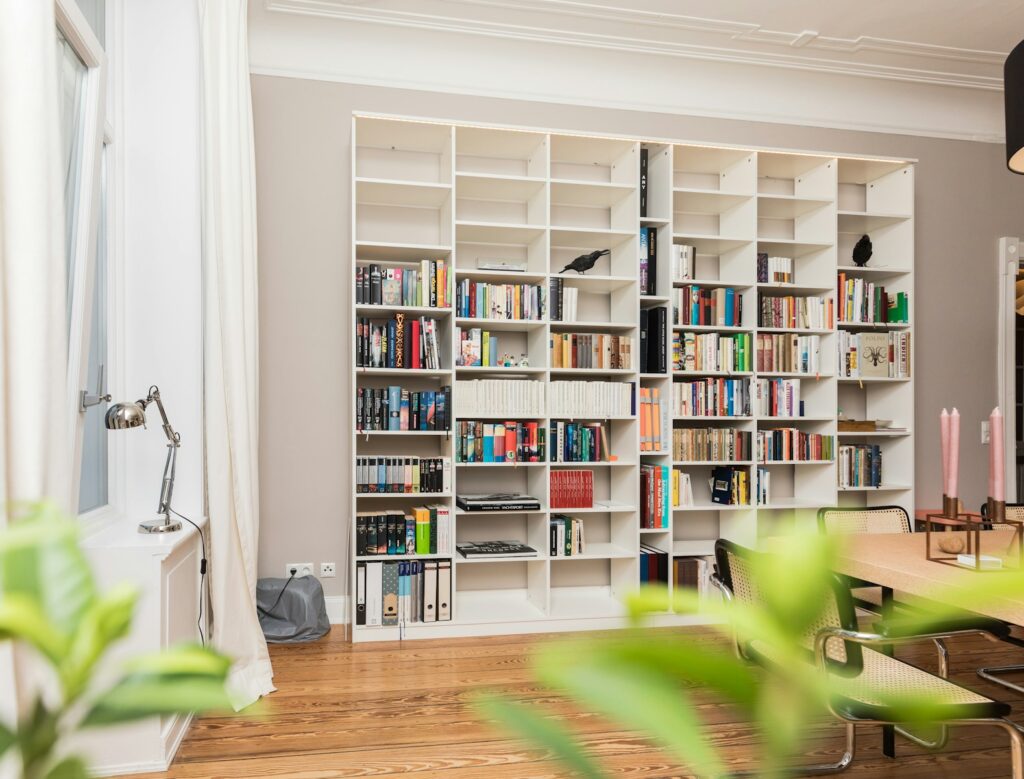Open shelves can be both a design dream and a challenge. Done well, they showcase personality and style; done poorly, they quickly become catchalls for clutter.
The secret lies in creating balance. This is achieved by using a mix of items, thoughtful placement, and breathing room to keep shelves looking curated instead of chaotic.
Follow the Rule of Thirds
A simple way to style shelves is to divide them into thirds visually. One section might feature stacked books, another a decorative object, and the last a plant. This formula helps distribute weight evenly, ensuring each shelf feels balanced without being overcrowded.
For more inspiration on creating balance in your home, see The Best Paint Colors to Brighten Dark Hallways.
Mix Heights and Shapes
Flat rows of similar items can look monotonous. Varying the height and shape of objects creates movement and draws the eye across the shelf. For example, pair a tall vase with a low bowl, or mix horizontal books with vertical picture frames to add depth and interest.
Incorporate Greenery
Plants are an instant antidote to sterile shelves. Small potted succulents, trailing ivy, or even faux greenery add softness and life. Greenery also introduces organic shapes that break up rigid lines, making the shelves feel more natural and approachable.
Love adding greenery indoors? Check out The Beginner’s Guide to Cutting Gardens for fresh flower inspiration.
Curate with Intentionality
Not everything needs to be on display. Select a handful of meaningful or visually appealing items and let them stand out. Editing down ensures your shelves look deliberate, not crowded. Rotate pieces seasonally to refresh the look without overloading.
Play with Texture and Material
Mix open shelving materials, such as wood, glass, ceramic, and metal, to add dimension. A glossy vase next to a woven basket feels more dynamic than placing similar textures side by side. Textural variety helps prevent visual monotony and creates a layered, designer feel.
Leave Negative Space
Space is just as important as filled space. Leaving breathing room around objects prevents shelves from feeling cluttered and highlights each item. Think of it as giving your favorite pieces room to stand out.
Use Books as Building Blocks
Books are versatile styling tools. Stack a few horizontally to create a pedestal for a decorative object, or line them vertically to frame smaller items. Mixing book orientations adds structure and makes shelves feel layered and intentional.
Add Personal Touches
Shelves feel more authentic when they reflect your story. Display travel souvenirs, framed photos, or heirloom pieces alongside decorative objects. Personal touches make the shelves warm and inviting while ensuring the design doesn’t look staged or generic.
For more cozy design inspiration, check out Summer-to-Fall Decorating Transition Tips.
Balance Color Palettes
Too many competing colors can make shelves feel chaotic. Stick to a cohesive palette. That might be neutrals with pops of greenery, or a mix of metallics with muted tones. Repeating colors across different objects ties the look together, making the styling feel polished.
Rotate Seasonally
Refreshing your shelves a few times a year keeps the look lively. Swap in seasonal décor or new finds while storing others, so your shelves always feel updated without adding clutter.
The Polished Look
When styled with balance and intention, open shelves can elevate a room rather than overwhelm it. By using formulas, mixing textures, and leaving space, you can create a display that feels curated, personal, and effortlessly polished.




